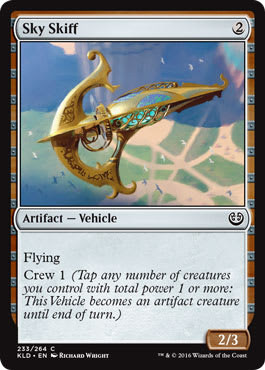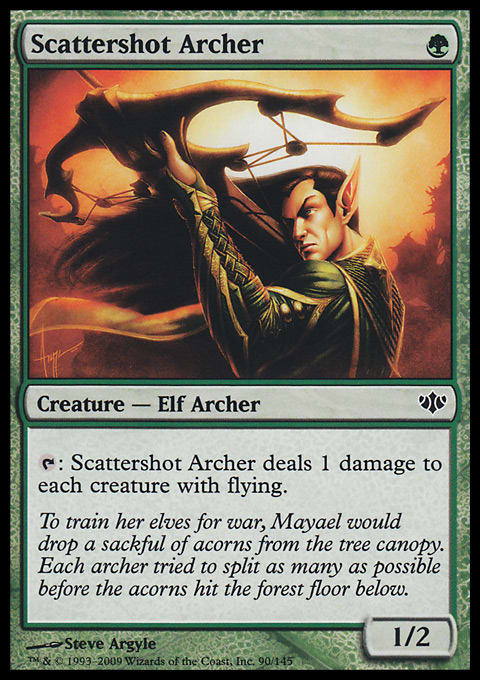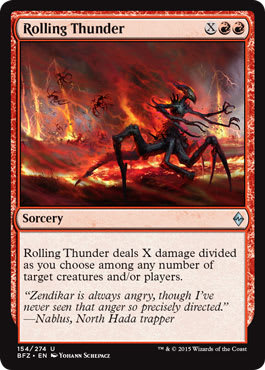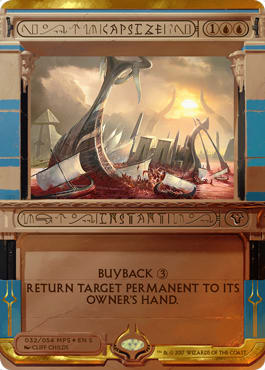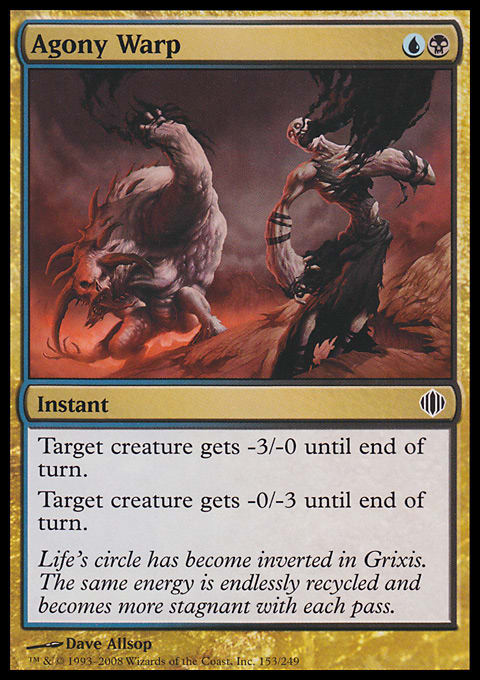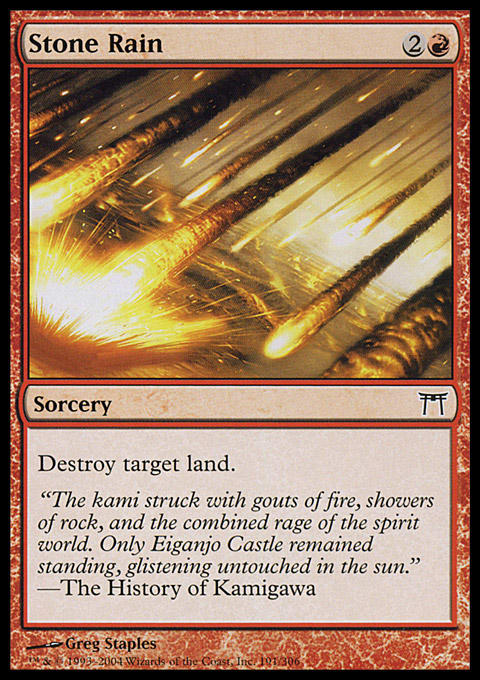Since the release of Eternal Masters Peregrine Drake based combo decks have utterly dominated competitive Pauper. Out of the nearly 960 decks that have gone undefeated since Drake’s debut over 26% — 254 — have used the Urza’s Saga card as part of their game ending engine. While there are many shells they all have something in common, and that is their reliance on the combination of Peregrine Drake, Ghostly Flicker, and Mnemonic Wall (or Archaeomancer) to generate a massive advantage that often correlates to victory.
Peregrine Drake is not the first card to facilitate this combo in Pauper. Cloud of Faeries did it first with the aid of Nightscape Familiar and Sunscape Familiar. Esper Combo combined these cost reducers with lands like Dimir Aqueduct and Azorius Chancery to generate an unbound amount of mana and either win with an army of Mulldrifters or with Sage's Row Denizen triggers. The deck was incredibly resilient as every piece was part of the combo and with access to some of the best blue card draw and selection spells in the history of Magic it could go off by turn four with relative ease.
Esper Combo ? Pauper| 5-0 Pauper League, January 23 2016, Magicverse
- Creatures (21)
- 1 Lone Missionary
- 1 Sage's Row Denizen
- 2 Nightscape Familiar
- 2 Sea Gate Oracle
- 3 Mnemonic Wall
- 4 Cloud of Faeries
- 4 Mulldrifter
- 4 Sunscape Familiar
- Spells (17)
- 1 Reaping the Graves
- 3 Ghostly Flicker
- 4 Snap
- 1 Foresee
- 4 Compulsive Research
- 4 Preordain
- Lands (22)
- 2 Plains
- 2 Swamp
- 6 Island
- 1 Terramorphic Expanse
- 3 Dimir Aqueduct
- 4 Azorius Chancery
- 4 Evolving Wilds
- Sideboard (15)
- 2 Lone Missionary
- 1 Foresee
- 2 Circle of Protection Blue
- 2 Circle of Protection Green
- 1 Circle of Protection Red
- 2 Dispel
- 1 Doom Blade
- 3 Hoodwink
- 1 Rest for the Weary
The release of Oath of the Gatewatch saw Cloud of Faeries added to the banned list and signaled the end of Esper Combo. While Cloud of Faeries combo topped out at 15% of the undefeated metagame the presence of Cloud in Delver Blue decks, where it could facilitate a shutdown opening with Spellstutter Sprite, led to Blue being far and away the best option in Pauper. Citing the interest of color diversity, Cloud was banned. Delver quickly found a replacement in Faerie Miscreant and was no worse for the wear.
Esper Combo was powerful but it was a pure combo deck. It relied heavily on Cloud of Faeries and because of that it was vulnerable to cards like Scattershot Archer, Aerial Volley, Electrickery, and similar effects. To be fair these were hardly a slam dunk on par with Gorilla Shaman against Affinity but they did help to throw a wrench in the works. Additionally, because Cloud of Faeries only untapped two lands the deck leaned harder on its cost reducers. To combat hate the combo deck had Reaping the Graves to reload on key components which meant winning the race by turn three or facing an insurmountable advantage.
In my naiveté, I believed that the additional cost on Peregrine Drake would make it easier to fight than Cloud of Faeries. I also thought that the lack of additional application — Cloud had a home in aggressive tempo decks as well — would limit the impact of Drake. Clearly I had not listened to Mark Rosewater enough when he said that the “Free Mechanic” featured on Cloud of Faeries and Peregrine Drake was one where adding mana to the cost actually made it better. It reduced the reliance on Familiars and allowed the package to find a home in a non-dedicated combo deck.
Peregrine Drake combo has a few distinct shapes. While there are some players who have maintained the Esper shell with either a Gray Merchant of Asphodel or a Sage's Row Denizen kill far more have adopted a U/R build that plays more like a control deck.
Izzet Drake ? Pauper| 5-0 Pauper League, Borzoi, October 4, 2016
- Creatures (15)
- 3 Archaeomancer
- 4 Mulldrifter
- 4 Peregrine Drake
- 4 Sea Gate Oracle
- Spells (23)
- 3 Ghostly Flicker
- 4 Counterspell
- 4 Lightning Bolt
- 1 Firebolt
- 3 Compulsive Research
- 4 Flame Slash
- 4 Preordain
- Lands (22)
- 4 Mountain
- 8 Island
- 1 Forgotten Cave
- 1 Lonely Sandbar
- 4 Izzet Boilerworks
- 4 Swiftwater Cliffs
- Sideboard (15)
- 2 Dispel
- 2 Gorilla Shaman
- 4 Pyroblast
- 3 Electrickery
- 4 Hydroblast
Izzet Drake is an evolution of Izzet Control, a deck that while popular was a fringe contender at best. The deck lacked a way to close out games. That is no longer the case. Subpar win conditions were swapped out for the Drake combo package and a dominant force was born. Initially these decks included Rolling Thunder or Kaervek's Torch as a way to win the game immediately but their inclusion is hardly mandatory. These Drake decks are capable of either winning with Peregrine Drake and Mulldrifter in the air, recurring Lightning Bolt, or looping Compulsive Research to force an opponent to draw their entire library.
The combo works like this: Peregrine Drake untaps up to five lands. Often this will include an Izzet Boilerworks so the first loop generates a single mana. With either an Archaeomancer or a Mnemonic Wall in play, a Ghostly Flicker will then target the Drake and the creature that re-buys the spell. Lands are tapped in response and then untapped and this repeats until there is enough mana to spend excess on Sea Gate Oracle or Mulldrifter to find additional threats. Eventually the board is either filled with 2 power flying creatures or there is enough mana generated to start using the cycle to reuse Lightning Bolt enough times to end the game.
Izzet Drake is significantly more popular than Esper Combo at its height. Part of this may have to do with the fact that because Drake untaps five lands as opposed to two it is easier to win against the clock. One of the biggest factors, anecdotally, that kept Esper down was that it was incredibly click intense. Players who were not skilled in the cycle could often time themselves out of a match. That Drake untaps five lands, has an easier time winning with attacks, and has a decent midrange shell around the combo means that ending the game is far more attainable. Another factor may be the cost. Esper Combo relied on cards from Planeshift to operate at peak efficiency and they were in rather pricey for Pauper. Considering that many people who play Pauper do so due to the low monetary barrier for entry these cards were outside their price range. Izzet Drake is far less expensive, especially if one eschews Pyroblast and Hydroblast in the sideboard. These cards can be replaced with the far more budget friendly Dispel and Gigadrowse. All these factors contribute to the fact that Izzet Drake as a popular deck that is likely to appear around one time during any given league run.
Simic Drake Tron ? Pauper| 5-0 Pauper League, kleuter, October 3, 2016
- Creatures (10)
- 2 Mnemonic Wall
- 4 Mulldrifter
- 4 Sea Gate Oracle
- Spells (26)
- 1 Capsize
- 3 Tangle
- 4 Ghostly Flicker
- 3 Foresee
- 4 Compulsive Research
- 4 Explore
- 3 Expedition Map
- 4 Prophetic Prism
- Lands (24)
- 1 Remote Isle
- 4 Simic Growth Chamber
- 4 Thornwood Falls
- 4 Urza's Mine
- 4 Urza's Power Plant
- 4 Urza's Tower
- 3 Snow-Covered Island
- Sideboard (15)
- 1 Tangle
- 3 Fangren Marauder
- 4 Hydroblast
- 3 Dispel
- 2 Hoodwink
- 2 Moment's Peace
The other popular Drake deck takes a slightly different approach. Relying on the UrzaTron to generate mana, Simic Drake Tron protects itself with Tangle and Moment's Peace. Lacking Red spells this version kills with either flying attacks, looped Compulsive Research and Deep Analysis, or by casting a one-sided Obliterate with a combo-fueled Capsize. Occasionally these versions will find home for a singleton Kaervek's Torch, splashed off of Prophetic Prism but it is not required. The Simic version of the Drake and Tron mash-up wants to get the combo online as soon as possible and facilitates this with Expedition Map and Explore. It is possible to start the machinations as early as turn three with a perfect draw. The minimal number of natural Blue sources adds an additional restriction but the ability to Flicker Prism provides an expensive way to convert colorless mana into the correct color.
Peregrine Drake decks operate in a manner similar to tap out style control. The Izzet variety wants to spend all its mana every turn, whether this is casting a Ponder or Preordain or committing a Swiftwater Cliffs to the board or casting Sea Gate Oracle. The goal is to stay alive until it can cast a Peregrine Drake with some protection and then proceed with the combo cycle, at which point they convert from a control deck into a combo deck. The Tron builds are less concerned with removing creatures from the battlefield and instead try to stabilize by simply negating combat. Neither of these decks run an abundance of countermagic in the main deck and understanding that they are largely defensive until the fourth or fifth turn can inform the best way to attack the dominant force.
There are many ways to attack Peregrine Drake decks. The most common way, at least currently, appears to be a straight race. Decks are trying to win before Drake can assemble the combo whether that be through Stompy, Delver (with Phantasmal Bear over Spire Golem), or various Red decks with burn spells for reach. The recently popular 14-Land Black deck also attempts to win on this axis, using Shepherd of Rot as a way to deal the with the final life points.
Black Beatdown ? Pauper| 5-0 Pauper league, The_zzz, October 7, 2016
- Creatures (33)
- 2 Barrow Ghoul
- 3 Bonded Construct
- 4 Carnophage
- 4 Carrion Feeder
- 4 Night Market Lookout
- 4 Pulse Tracker
- 4 Shepherd of Rot
- 4 Thornbow Archer
- 4 Vampire Lacerator
- Spells (13)
- 4 Dark Ritual
- 4 Foul-Tongue Shriek
- 4 Snuff Out
- 1 Renegade Freighter
- Lands (14)
- 14 Swamp
- Sideboard (15)
- 4 Disciple of the Vault
- 4 Gut Shot
- 4 Shrivel
- 3 Spinning Darkness
Another way to combat Drake is to go after the different pieces of the puzzle. Peregrine Drake is a 3 toughness creature which means almost every commonly played removal spell can take it off the table. The need to deal with these creatures in a tempo positive way means that cheap instant speed removal is at a premium. We have seen a rise in Dimir Delver recently, perhaps for just this reason. Agony Warp and Ghastly Demise matchup much better than Chainer's Edict against a deck focused on the Drake cycle. It follows that other similar removal, like Vendetta, Last Gasp, Grasp of Darkness, Aerial Volley, and Harvest Pyre should also go up in value. Targeting the other half of the combo — whether it be Archaeomancer or Mnemonic Wall — also can delay the combo. Taking out Archaeomancer is easier but Mnemonic Wall falls to many of the larger removal spells. We could be seeing a rise in Doom Blade and Terminate as a way to hit either creature. While it does miss Wall, Branching Bolt, a card without a home currently, can hit both Archaeomancer and Peregrine Drake and potentially buy tons of time. Maybe it will take off but the correct shell will need to be found.
Trying to remove Ghostly Flicker is also viable. Liquify, Spell Shrivel, Syncopate, and Faerie Trickery can all exile the spell from the stack. Castigate can take it out of hand while Relic of Progenitus, Nihil Spellbomb, and Bojuka Bog can all take it out of the yard once resolved. Faerie Macabre is uncounterable but has the issue same issue as other graveyard removal: it has little utility against the value plan Drake decks can employ.
Similarly Stone Rain and similar effects have minimal efficacy against Peregrine Drake decks. This is nothing about the strength of the spells but everything to do with the follow up. In order for land destruction to work it has to come with a reasonable threat. Avalanche Riders does not exist at common and as such it is a challenge to follow up a 3-mana spell with a sizeable beater that also leaves up the potential for removal. It is plausible that Boomerang and Hoodwink are better options as they connect on turn two and have utility outside hitting land.
The issue with many of these answers is that they are Blue. In it of itself this is not a bad thing but Blue, and to a lesser extent Red, have crowded other colors out of Pauper. Green exists to support Rancor but outside of that there are very few Forests. Similarly White and Black are almost non-existent at the top of the metagame. Being able to have some control over the stack is important if one is not attempting to race against Drake.
Whether or not Peregrine Drake deserves to be banned is a question for another day. When looking to beat the deck it is important to focus on the following elements. You can either race the deck or attempt to disrupt its pieces. Targeting the Mnemonic Wall effect or Ghostly Flicker is likely better in the abstract but is also harder to achieve. Understanding that Drake represents the best endgame means that in order to win, you cannot wait until turn six. Apply pressure, rinse, repeat.














